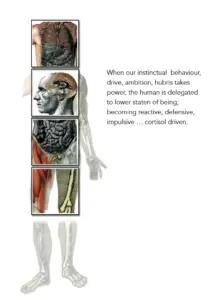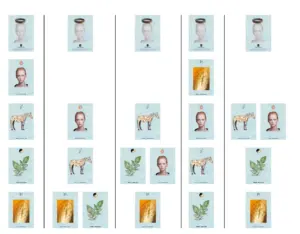Constellations – the art and science of
The understanding of the forces at work that disturb, alter, reorganise, and overpower the differing realms within us, and the ability to help reorganise the autonomy and authority of a human being

Ideally, when our inherent internal human structure is congruent, we can function and fully realise our potential, and understand our purpose
Systemic or Family Constellations are some of the names used for the work by the renowned German psychologist Bert Hellinger. Parallel to his work but unknown to each other, Solihin Thom and his colleague Francois Reynolds, who was followed at a later date by Alicia Thom, developed what we now call the Human Template Model. The use of constellations characterizes both Hellinger’s work and ours: the practice of using the ‘knowing field‘ (a term coined by Dr. Albrecht Mahr) to elicit a dialogue-response in participants to illustrate the dynamics of a particular set-up of representative participants who are constellated (like a star formation) around a specific ‘sun’. In Hellinger’s work, the sun may be a principal person and his or her relationship and/or the principal’s family dynamics. However, the approach taken by InnerDialogue, the constellated ‘sun’ will be a principle–the Divine, goal, mission, personal deity, the person, illness, business, or an idea propagated by human thought or inquiry–and the surrounding constellation will be the sum of parts involved.
![]()
This HTM Constellation is ontological, which helps us reveal and look at the root cause that created the original or consequent accidents that predisposed the disorganization of the entity called ‘human’. This same premise can be illustrated in a business organisation, as the two systems are identical. The premise of the ontological map is that we humans are composed of elements that once were described as part of the Great Chain of Being. We are composed of our phylogenetic past and contain evolutionary elements that predispose us to their influence. Thus, a human is influenced by our:

- ancestral and own history and DNA (reflexive and reptilian self); cellular matrix
- his internal environment and sensory nature (feelings, emotions) and vegetative autonomic brain; or vegetal self; organ and system matrix
- sexuality, habits, tribe, survival, movement–mammalian or rhinencephalic brain (including the amygdala and hippocampus) or instinctual self; rhinencephalon, joints, muscles, lungs, heart, instincts
- and beliefs, ideas, analytical and gestalt thoughts, theology (neocortical brain), or human self; executive functioning.
These different natures all contain mass. When altered, each may affect us as their mass transforms into energy, and then, when this mass moves and influences us, it acts as a force. Each force, relative to its rank or station, affects us differently. Each level of being exhibits a different force, which affects us in particular ways, upsetting our original hierarchical set of natures. In classical Islamic theology, these selves or elements of mass are called the lower natures or nafs. In Western culture, we may allude to these nafs as some negative passion or emotional or base instinct as an element of the human which has taken power. We may say, ‘he’s subhuman, or that someone acts as a ‘pig’, or indicate that someone who is not very proactive is a ‘couch potato’. Someone we cannot quite get hold of, as ’slippery as an eel, or ‘sly as a fox’. These terms elicit a metaphorical narrative and allow us to convey the sense of the principal life force that the person operates from (at that present moment or at the time of the narrative).
In a constellation, the principle (person) lays out their ‘cards’ (the story or dynamic they wish to unravel) by using people to illustrate each level of being. They are ‘in’ the constellation and use others to represent their lower or other-selves. In a business, for example, a manager may well be the main participant and will choose others to represent parts of the company, as in someone representing the back office, another as the middle, and one as the front office, or conversely other lookers-on will come out by their own accord. The participant populates the constellation around them, placing intuitively each into a particular place close, near or far from their standing position.
This constellation may be structured (‘Here are the elements in their order, please fill them with people who represent your differing selves‘), or haphazard (‘Place others around you to represent your differing selves in whatever way you are guided‘). This would be their opening representation. It relays (broadcasts) their state.

A very generalized arrangement of the internal disorder of human beings (‘correct’ relationship on the left).
In a company, business, or organisation, the order and function of the varying elements within the system may be out of order. This often reflects on the management and their governing style. Equally, the company purpose or values set out in a company manifesto may be askew or discarded, leaving the staff and workers in a state of the unknown, purposeless or unmotivated. Values may be articulated but not manifest or apparent. Business practice may be said to be run on a level playing field and to be horizontal but is, in fact, still, in the classic management sense, hierarchical with no real laterality, interoperable or actual cooperative function. Human beings are hierarchical but also co-exist in social and work environments as an extension of each other. Hence, many companies espouse the horizontal cooperative dynamic today and ‘do away with’ the old model of hierarchical management structure. The more we are internally disarranged, the more this cooperative horizontal networking breaks down negatively.
We use the act of surrender–or interior quietness and silence to guide us in this constellation process. After the initial set-up, we ask all the participants in the constellation or those watching to surrender. We can call this a stop-motion process to facilitate the unravelling or unfolding of the constellation. The act of surrender to the Divine, a Higher Purpose, and a bigger Self (a central tenet) allows us to be guided, as the participants acting as elements of the principle illustrate their receiving (guidance). When the surrender is over, they can talk about their inner experience, standing where they have been placed.
“They may articulate that they feel a resonance, or that their body temperature has changed, or that they twisted, or felt sick, sad, remorseful, or that they had wanted to move–indeed some may have moved in the surrender–or tell you a vision, words or ideas, or even what they have ‘heard’.”
These signals, sensations, and physiological states occur while the person surrenders. We try not to get the person to talk too much, knowing how easily humans can articulate through their own filters, thoughts about the ‘other’, or patterns.
The facilitator guides the process by repeatedly asking the participants to surrender. In this way, the constellation unravels, opens up, and reveals the principle’s state and resolution. In practice, the facilitator uses the feedback from the participating ‘elements’ to guide the re-arranging of the constellation based on what is articulated. As we can access signals or information through the various elements of our physical body, we can be guided into understanding what each component is saying. This is complex and sophisticated work, and at some level, demands an expert to help. On the other hand, we can extrapolate and be guided by our reference and understanding, so this work can work either way.
The human body receives information from different parts of the organism. It is like the wisdom inherited from the differing life forms that are phylogenetically within us, and we can listen to this collective orchestra. This is why we have such terms as innate, intuitive, instinctive, and human nous as differing aspects of these internal insights. We also observe what we might call received wisdom, which is of a higher order. However, as an organism equipped with a neocortex, we can construct or create reality and articulate thoughts which appear to be true–that is, we can manufacture signals through our own needs, proclivities, immaturity, and hubris. The facilitator needs to be sufficiently aware of this as the constellation proceeds.
NB “To counter this, we teach another workshop called the art and science of InnerListening– a sophisticated training that goes hand-in-hand with constellation work, that allows us to switch on and develop the capacity to receive and be aware of information broadcast from the other–or in a constellation when we receive for ourselves as representative elements.”
Through surrender, our differing selves/elements feed the human mind (in its mindful state) with information pertinent to the situation. This process may also descend upon us to give us an alternative reality when our sensory guidance cannot ‘see’ or ‘hear, feel’ or ‘notice’ what needs to be accessed. This is the action of Grace, and it is the act of surrender that allows us to receive somatosensory information representational to the situation or to be given noetic understanding through received understanding.
- The facilitator re-arranges the constellation as per ‘picture’ or stop-frame and then proceeds with further surrender or quiet to allow the participants to be guided further. This enables the constellation to evolve–actually to unfold like a spiral of creativity, a torus within THE whole. The narrative can unfold in many different ways with the addition of further revealed qualities (again mirrored by participants acting out these elements or qualities). The unfolding narrative may illustrate the distortion present or elicit the force which has become dominant and holds the person ‘captive’ or disordered. It may bring in other elements, such as ancestors, ‘ghosts’, unfinished business, and discarded parts–either new or missing resources that would augment changes in the person (or manager, if we revert to a business model) to shift their state. We can finish the constellation where all human parts are intact and present or stop the constellation to illustrate the state. We can be as creative as we want but always have the participant or person in mind so their constellation creates the bridge to change or restructure their internal order.
The constellation process can take a few minutes to several hours, and many years ago, when we were not very critical, it could go on over a whole day. The primary outcome is:
- For the participant to observe and understand the complexity of being a human.
- To recognise the forces (around and within them) and how they may upset their internal structure and order.
- How this disorder causes repetitive and negative patterns and hinders growth and understanding.
- They must see and understand the psychospiritual tools to help them shift state and hold this new dynamic.
- To go away with an understanding and the will to maintain this new internal state so that they function, at the least, better than they were or to be optimal in their work, family and social systems.
- It is essential to be able to notice, be aware and attentive, and then be mindful of what it is to be a human being.